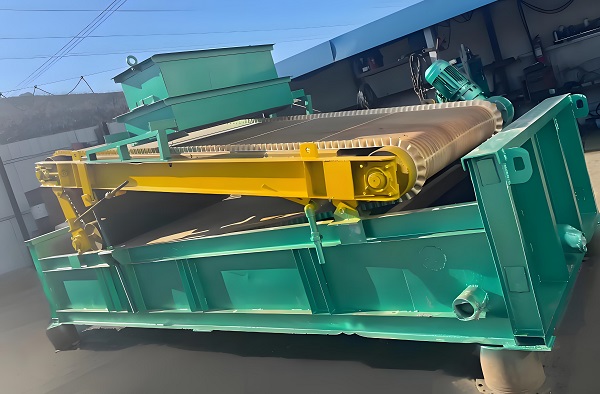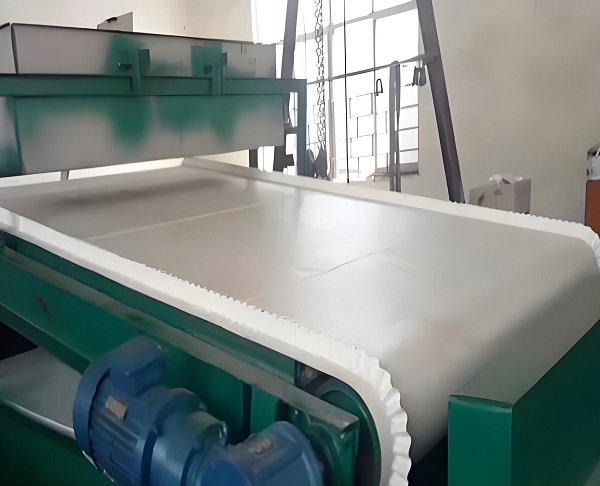The increasing demands for separation precision and efficiency in fields such as mineral development and new energy materials have rendered traditional magnetic separators inadequate. The new generation of magnetic separators, launched in 2025, integrates cutting-edge technologies such as high-gradient magnetic systems and intelligent sensing, achieving significant breakthroughs in magnetic field strength and energy consumption control. It also establishes an application system covering multiple industries. Not only can it overcome the challenge of weak magnetic separation, but it can also adapt to complex working conditions, becoming a key piece of equipment driving industrial purification and resource recycling upgrades. The following section will delve into its core technologies and full-scenario applications.

Against the backdrop of continuously escalating demands for separation precision and efficiency in fields such as mineral development, environmental recycling, and new energy materials, magnetic separator technology has achieved a leapfrog development from "extensive separation" to "precise control," and from "single function" to "system adaptation." The new generation of magnetic separators, launched in 2025, integrates cutting-edge technologies such as high-gradient magnetic systems, intelligent sensing, and superconducting materials, achieving significant breakthroughs in magnetic field strength, separation efficiency, and energy consumption control. Simultaneously, it forms a full-scenario application system covering eight major industries, becoming a core piece of equipment driving industrial purification and resource recycling upgrades. I. Core Technology Breakthroughs: Reconstructing the Boundaries of Magnetic Separation Performance
1. High Magnetic Strength and High Gradient Technology: Overcoming the Challenge of Separating Weak Magnetic Materials
Addressing the pain point of traditional equipment's inability to adsorb small and weakly magnetic substances, the new generation of magnetic separators achieves a performance leap through innovation in magnetic materials and structure. Zhongwen Magnetic Separation's independently developed second-generation strong magnetic system uses high-energy-product neodymium iron boron material, with a surface magnetic induction intensity exceeding 20,000G, a 33% improvement over the industry average. It can effectively adsorb tiny iron filings with a diameter of less than 0.05mm, achieving an iron impurity removal rate of over 99%. The high-gradient magnetic separator has also achieved a technological breakthrough. Through a design of "densely packed magnetic conductive media + multi-pole magnetic system superposition," the magnetic field gradient is increased to 22,000Gs/cm, more than four times that of traditional equipment. Even for weakly magnetic minerals such as rhodochrosite, the recovery rate can be increased from 65% to over 90%.
The commercial application of superconducting magnetic separation technology has further refreshed industry understanding. Utilizing low-temperature superconducting coils to generate a strong magnetic field exceeding 50,000 Gauss, it can capture nanoscale ferromagnetic particles, providing solutions for high-purity applications such as new energy materials. After 1000 hours of aging testing, the new magnetic system exhibits a demagnetization rate of ≤3%, extending its service life to 8-10 years and significantly reducing maintenance costs.
2. Intelligent Control System: Achieving Precise Control Throughout the Process
The deep integration of IoT and AI technologies has transformed magnetic separators from passive operation to active control. New-generation equipment is generally equipped with a PLC control system and a multi-dimensional sensor matrix, enabling optimization of the magnetic field distribution through Ansys Maxwell magnetic circuit simulation, achieving stepless adjustment of the magnetic field strength from 8000-25000 Gs. In iron ore beneficiation plants, the system can automatically adjust parameters within 10 seconds based on fluctuations in raw ore grade, ensuring a stable concentrate grade above 65% without manual intervention.

The fault diagnosis and remote operation and maintenance system has become more sophisticated. Data is collected through sensors such as vibration, temperature, and current to establish a fault database including features like magnetic system loosening and coil short circuits. The accuracy rate of identification using neural network algorithms reaches 95%. In a steel plant application, the system provides a 24-hour advance warning of bearing wear, extending the average time between failures (MTBF) to over 1000 hours, with a response speed of ≤1 minute. The application of digital twin technology further enables virtual simulation optimization. In a home appliance production line, simulating the magnetic system layout improved iron removal efficiency by 15%.
3. Green and Energy-Saving Design: Balancing High Efficiency and Low Carbon
Driven by the "dual carbon" goal, magnetic separators fully implement energy-saving concepts from materials and structure to operating modes. The magnetic system design, through asymmetrical magnetic pole layout and magnetic shielding technology, reduces the amount of magnets used by more than 20% under the same magnetic field strength. Combined with a "tile-like" magnet arrangement, the magnetic field is concentrated in the working area, reducing leakage magnetic loss. Electromagnetic separators are equipped with a frequency conversion control system that automatically adjusts the current based on the iron content of the material, saving 30% more energy than traditional constant current modes. Superconducting magnetic separators utilize zero resistance, resulting in near-zero energy consumption.
Jinhuan Magnetic Separation's SJ energy-saving slurry high-gradient magnetic separator, through its "dual-cycle" high-efficiency cooling technology, doubles its processing capacity while reducing unit energy consumption by over 50%. Material upgrades also contribute to energy savings; the 316L stainless steel magnetic media coated with tungsten carbide improves wear resistance by two times, extending the replacement cycle from 3 months to 18 months and reducing maintenance costs by 40%.
4. Modular and Weather-Resistant Design: Adaptable to Complex Working Conditions
Modular design has become a standard feature for different industry material characteristics. Zhongwen Magnetic Separation offers 10+ series equipment: the AA series high-intensity magnetic drum is suitable for aggregate processing, the WCX series fine powder magnetic separator specializes in the chemical and grain industries, and the CTB series wet separator serves metal beneficiation. High-gradient magnetic separators, through streamlined flow channels and turbulent flow guidance design, reduce flow channel resistance by 30%. Combined with a 15°-20° inclined discharge port, this completely solves the problem of material retention and blockage. At one sand and gravel plant, the equipment cleaning cycle was extended from once daily to once weekly.

Adaptability to extreme environments is significantly enhanced. Magnetic separators for marine engineering utilize 2205 duplex stainless steel bodies and salt spray-resistant samarium-cobalt permanent magnets, controlling the iron content on the material surface to below 0.05 mg/m², extending the lifespan of offshore equipment. For acidic slurry scenarios, the outer shell is made of Hastelloy alloy, achieving 2 years of rust-free operation; models for the food industry adopt a fully enclosed structure, meeting GMP cleanroom standards.
Upgraded Applications Across All Scenarios: From Resource Development to Environmental Recycling
1. Mining Sector: Efficient Enrichment of Low-Grade Resources
In metal beneficiation scenarios, the new generation of magnetic separators has become key equipment for the development of low-grade ore. After replacing its equipment with Zhongwen CTB series wet magnetic separators, a metal ore beneficiation plant increased its hourly processing capacity from 200 tons to 400 tons, raw ore utilization from 75% to 88%, and reduced annual costs by 5 million yuan. Hengci Technology's optimized high-gradient magnetic separator, applied in a hematite beneficiation plant, increased the recovery rate of weakly magnetic minerals from 78% to 95%, improved concentrate grade by 6 percentage points, and increased annual production of high-grade iron concentrate by 20,000 tons, generating over 12 million yuan in additional revenue.
Rare metal separation shows even greater advantages. The SLon-8000 vertical ring pulsating high-gradient magnetic separator overcomes the challenge of separating -400 mesh ultrafine particles, reducing the fine mineral miss rate from 12% to 3% in an ilmenite beneficiation plant, and controlling the titanium content of tailings below 0.5%. 1. **High-gradient magnetic separation technology:** For difficult-to-process minerals such as chromite and wolframite, high-gradient magnetic separation achieves efficient purification, boosting resource utilization.

2. New Energy Materials: Ensuring High-Purity Production:** The production of lithium-ion battery cathode materials requires extremely stringent control of iron impurities, making multi-stage magnetic separation a core quality assurance process. In lithium iron phosphate production lines, large iron particles are first removed using a suspended permanent magnet separator, followed by deep iron removal using a pipeline high-gradient magnetic separator, controlling the iron content below 0.001%. After introducing an intelligent magnetic separation system, a new energy materials plant increased its product qualification rate from 88% to 99.5%, completely resolving battery safety concerns.
In rare earth resource development, high-gradient magnetic separators precisely separate weakly magnetic rare earth minerals. Combined with real-time control using intelligent grade analyzers, this increases rare earth recovery rates by over 20%. Superconducting magnetic separators play a role in the purification of nanoscale materials, providing raw material security for high-end fields such as new energy vehicles and energy storage batteries.
3. Environmental Protection and Recycling: Supporting the Development of a Circular Economy
In the recycling of municipal solid waste and construction waste, magnetic separators achieve dual value in terms of resource utilization and environmental protection. A construction waste recycling project uses a wide-span suspended magnetic separator in conjunction with a drum-type separator to form a "coarse-fine" process, achieving a magnetic metal recovery rate of 95% and reducing the iron impurity content of recycled aggregates to below 0.05%, meeting the standards for construction sand. In electronic waste treatment, strong magnetic separators separate weakly magnetic hazardous substances such as nickel battery casings, achieving a separation rate of 70% and reducing the risk of heavy metal pollution.
Industrial solid waste treatment is even more effective. An overseas energy company installed RCYB series fully automatic iron unloading separators in its coal transportation system, achieving an iron impurity adsorption rate of 99%, extending the life of coal conveyor belts by 2 times, and reducing annual maintenance costs by 40%. In the abrasive and grinding tool industry, WCX series fine powder magnetic separators increased the iron impurity removal rate to 99.5%, boosting the product qualification rate from 80% to 98%, and increasing order volume by 30%.

4. High-end Manufacturing and Food: Strict Control of Product Purity
In precision manufacturing, magnetic separators have become a key component of quality control. In automotive stamping production lines, magnetic separators and robotic arms are linked via the PROFINET protocol, enabling 360° detection of 0.1mm-level iron impurities with a response time of ≤0.5 seconds. This has reduced the product scrap rate from 1.2% to 0.1%, resulting in annual cost savings exceeding 3 million yuan. In marine engineering material processing, wide-width magnetic separators cover sheet metal conveyor lines exceeding 2 meters, effectively improving the corrosion resistance of stainless steel and titanium alloys.
In the food and pharmaceutical industries, where safety and compliance are paramount, pipeline magnetic separators achieve thorough iron removal when processing liquid raw materials, preventing metal contamination. In grain processing, permanent magnet separators remove iron nails and iron filings introduced during harvesting and transportation, ensuring food safety. After implementation, a flour mill reduced its product metal impurity detection rate to below 0.01%, achieving international quality certification.
By 2025, magnetic separators, thanks to technological breakthroughs such as high magnetic strength and intelligent operation, will break through traditional performance boundaries and demonstrate strong application value in fields such as mining, new energy, and environmental protection. This will not only improve resource utilization but also contribute to low-carbon development. With continuous technological iteration, they will be more precisely adapted to specific scenarios, providing strong support for cost reduction and efficiency improvement in the industrial sector and achieving sustainable development, thus propelling the magnetic separation industry towards a higher-quality development stage.
Save Time! Get A Detailed Quotation Quickly.
